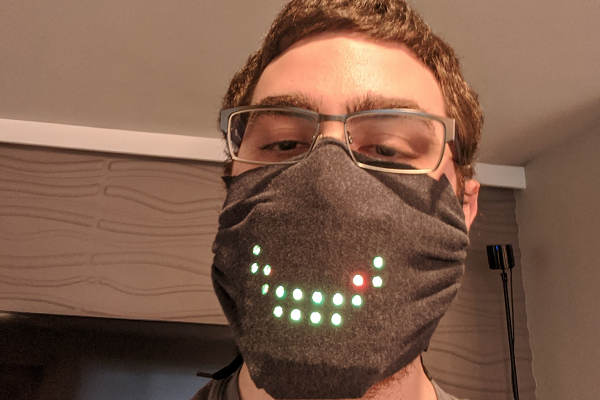Watch This Voice-Activated Light-Up Face Mask Speak and Smile
— Tyler Glaiel (@TylerGlaiel) May 25, 2020
A mask doesn’t have to hide your smile while protecting people around you from possible COVID-19 infection. Video game designer Tyler Glaiel has created a voice-activated panel of LED lights that can mimic someone talking or smiling even when their mouth is hidden behind the protective cloth.
Light Face
Masks are becoming a common sight globally as the COVID-19 health crisis continues. They’re a relatively cheap, simple way to protect people around you from potential infection. While maks limit how much of someone’s face is visible, Glaiel’s creation offers a fun way to compensate. He started with an 8×8 set of LED lights in a flexible matrix that fits in the pocket of a standard face mask. The lights link with electrical tape to a 9-volt battery and a microphone. A connected Arduino Nano microcomputer, basically a Raspberry Pi, contains the software Glaiel coded to run the system. When the system is on, two horizontal lines of lights appear. When the wearer speaks, the microphone detects the sound and the lights shift into a circle and back somewhat like a mouth opening and closing. As a bonus feature, when the wearer clicks their tongue, the light pattern shifts into a smile.
Glaiel shared all of the details on how to build the system on a Medium post, with the whole program available on GitHub. The components cost about $50 altogether, although there is room for some customization if the builder understands electronics and coding. According to an interview with the BBC, he toyed with adjusting how the lights respond based on the pitch of someone’s speech, but couldn’t get it to look like he wanted. He also made a point of saying that the lights are not the same as protective gear and that the LED setup should be cleaned regularly with ultraviolet light.
“I make no guarantees that this mask is safe or effective in stopping viruses,” Glaiel wrote. “Please refer to the CDC guidelines for cloth mask usage for more information. This is mostly meant as a novelty. Also please wash the mask (with the electronics removed) between uses. Stay safe out there!”
Creativity in a Pandemic
The responsive voice technology Glaiel applied to his mask echoes another DIY voice tech project prompted by the realities of life during the global medical crisis of COVID-19. Creative technologist Matt Reed decided to build an AI-powered clone named Zoombot to handle some of the many video meetings he is forced to endure while his office works from home. Zoombot uses speech recognition and text-to-speech to respond to common questions and comments from his colleagues during meetings. The digital clone also includes a video component that rotates through several images of Reed at his computer to mimic a bad connection.
Like Glaiel, Reed shared his software design on GitHub for anyone to take for their own Zoombot. That both creators see their projects as something anyone who knows a bit about programming could copy or even improve upon is indicative of how far voice technology has advanced over the last few years. Software that can understand and differentiate among different sounds and sentences no longer requires advanced or expensive equipment. Voice is only another element for personal electronics. The pandemic may be accelerating some experimentation, but the DIY voice tech community was already on the rise. Glaiel and Reed’s creations just make it possible for people to see you smile while masked because your digital clone is handling the Zoom meeting you’re skipping.
Follow @voicebotai Follow @erichschwartz
Bored of Zoom Meetings? Build a Digital Clone to Attend for You
Sensory Debuts New Combo Face and Voice ID Platform, Adds Cough and Sneeze Detection









